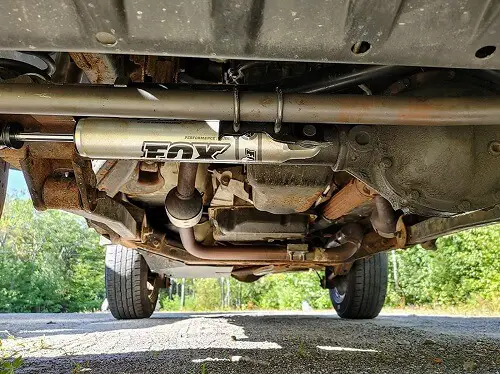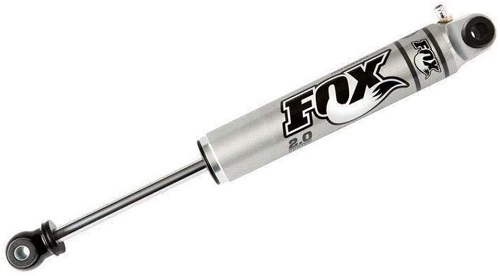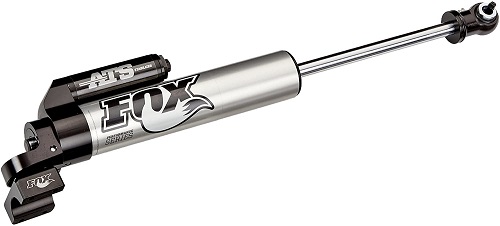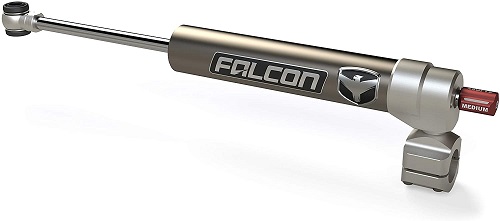
Do you ever feel like your steering wheel starts to get wobbly when you drive at high speed? Does it get unstable when you go off-road or clunky noises come out of the vehicle’s front end?
All these signs tell you that you need a steering stabilizer. This article is all about what steering stabilizers are and how these will help you improve the structural integrity of your vehicle.
First, let’s give the former question a brief discussion; what is a steering stabilizer?
It is a must-have piece of equipment that acts as a shock absorber. Some people also call it a steering damper. What you need to know about it is that it does not tighten the steering wheel.
That is nothing but a misconception. The main point of having a steering stabilizer is to minimize the external steering forces, which can cause twitching or make it more prone to bump steer.
You might as well call it just a shock for your steering.
How Does it Work?
Let’s talk about the mechanism; how does this simple yet highly effective piece of equipment solve such an aggravating problem for you?
The drag link connects to the side of a wheel, whereas the pit arm connects to the other side. The pit arm then forms a connection between the wheels and the steering box, which connects to the steering wheel. Thus it creates a link between wheels and the steering wheel.
What does it do, you may ask? When you steer the vehicle, you turn the steering box, which transfers a similar movement to the pit arm, making the drag link move back and forth. Hence, it orients the wheels in the right direction. When one of your tires hits a bump, it jostles up the drag link.
If you don’t have a steering stabilizer, this force will push the drag link in the pit arm through the steering box into the steering wheel, making the ride all rough and bumpy.
In such a case, the vehicle becomes hard to control. Getting a stabilizer would help by absorbing this shock, so the quick’s jabs from the bumpy road do not get a chance to travel through the steering linkage.
Misunderstanding About Steering Stabilizer
Just like other equipment, a steering stabilizer is prone to many myths. There are a lot of misunderstandings regarding these.
The most common misconception is that getting a stabilizer will cure your vehicle’s steering wheel problems, which is entirely untrue.
It isn’t a cure for a loose steering wheel. For that, you’ll have to take off the steering and do a whole maneuver which is a different story.
If you have some worn-out parts that require replacement, it won’t make much difference to them. These include tie rods and ball joints as these tend to go bad faster than other parts.
Getting a steering stabilizer won’t fix any of these problems.
Type of Steering Stabilizer Settings
Most commonly, there are three steering stabilizer settings. Each feels different while diving:
- The first setting is close to stock.
- The second setting increases the firmness of the steering wheel up to some extent.
- The third setting, in my opinion, is pretty stiff; some might say too stiff as the wheel shows reluctance in self-centering after a turn.
Therefore, setting two is what I use as well as suggest. The pass through the shaft design removes neutral position free play, causing the vibration in the wheel.
What is the Purpose of a Steering Stabilizer?
There are two primary purposes of a steering stabilizer. A, to get rid of the vibrations in the steering wheel (likely to occur at high speed), and b, reduction of radial pull for a more stable drive.
Stabilizers contain hydraulic fluid, which absorbs the shock of tires hitting objects at high speed. It ensures that the rest of the steering linkage system does not directly impact the shock and does not wear off ahead of time.
The second is the radial pull (discussed further below). High mount steering stabilizers create a stiff push against the tires’ radial pull, bringing the vehicle back on its straight track.
What Does a Steering Stabilizer Shock Do?
Steering stabilizers eliminate the vibrations and provide a more stable side-to-side movement of the vehicle.
The stabilizer body contains a pressurized oil and a shaft that slides in and out during operation. On the inside, there is a valve hooked onto the rod. This shaft slides through the oil, and this mechanism then leads to the steering wheel stabilizing.
Remember, if you take the damper off and the death wobble occurs, the intense vibration will overheat the oil and cause its mechanism to fail.
To make it simpler, a stabilizer is like an insurance policy that reduces vibration before the death wobble occurs. You need to look for the root cause separately.
So, a steering stabilizer isn’t meant for death wobbles; they work on the pre-wobble vibration and provide a smoother drive, but if you keep using one for that, it’ll wear off prematurely.
What Does a Steering Stabilizer Do on a Jeep?
A steering stabilizer is a part of your steering linkage system; it has nothing to do with the suspension whatsoever.
If you have tires larger than stock, stabilizers come in handy in avoiding the radial pull. What do I mean by that?
If your jeep has relatively bigger tires when you drive at high speed (with no stabilizers), the jeep starts to move either to the right or to the left on its own; it is the radial pull doing that.
What stabilizers do is push opposite to the radial pull keeping the vehicle in a forward direction.
They also help avoid the impact of bumps that might weaken the mechanism, so investing in a steering stabilizer is always a good idea.
What is the best steering stabilizer for jeep jk?
Below are some suggestions if you are looking for a steering stabilizer for your jeep jk. There are the top choices in the market and are pretty reliable.
FOX 2.0 IFP STEERING STABILIZER

If you are looking for a lightweight stabilizer that still provides durability, it is the one for you. The body of this stabilizer is good quality aluminum which also means no rust.
The floating piston mechanism is pretty cool as it keeps the shock fluid and nitrogen charge from mixing, ensuring fade-free performance all-out damping. Check the Latest Price of the Fox 2.0 IFP steering Stabilizer.
Fox 983-02-070 Performance Series Acts Stabilizer

For the ones who want looks and performance side by side, this stabilizer would work perfectly. The body is a seamless 2.0″ smooth bore and honed alloy structure for extravagant looks.
It guarantees optimal performance with its 24 clicks of external adjustment, integrated reservoir, zinc-plated, and double-clear coated body. Check the Latest Price of FOX 983-02-070 Steering Stabilizer
TeraFlex 01-02-22-110-138 Falcon Nexus 2.Fast Adjust EF Stabilizer

It is designed for the wobbling steering wheel of a jeep. 5/8″ sturdy chrome induction hardened shaft ensures resistance against rock damage and wear and tear.
It makes sure the jeep gets equal horizontal force for a consistent wheel response, which counts a lot, especially in a jeep jk. Check the latest price of Tera Flex Adjustable Steering Stabilizer
What Does a Steering Stabilizer Do on a Motorcycle?
Up till now, you probably have understood the importance of getting a stabilizer for your steering. Just like a fork and shock control your vehicle’s vertical motion, a steering stabilizer takes care of the horizontal side-to-side motion.
It even uses similar technology. Oil passes through a specific hole every time, causing the flow to restrict. It creates a damping effect that controls the speed of your front-end turning.
Types of Steering Stabilizers for motorcycle
There are three common types of stabilizers for motorcycles: Radial Linear and Electronic . Each comes with its utility and drawbacks. Let’s get right into it.
| Type | Radial | Linear |
| Mounting | Mounts on the top of a triple clamp | Mounts on the bottom or side of the triple clamp |
| Gap | A pronounced gap occurs when tires are straight. | Almost legible regardless of the direction of the tire. |
| Operation | Use a rotating pivot to control the bike’s motion | Piston and hydraulic-based operation |
| Adjustment | Difficult | Difficult |
| Installation | Difficult and tedious | Easy |
| Performance | Can be a bit rough due to dead spot* | Smooth |
Electronically controlled stabilizers that vary the damping based on the bike speed regardless of the style or location of the damper
*Note: remember, if you do not put back the stabilizer properly after servicing, it’ll end up with a dead spot and won’t cause the damping effect successfully.
Now for the part you’ve been waiting for, the electronic steering dampers.
As the name shows, these are controlled through stabilizers; thus, you can control the damping effect depending on your bike’s speed irrespective of the driving location style.
These stabilizers operate with rotary dampers through which hydraulic liquid flows freely yet slowly.
These provide a smooth driving experience and eliminate all sorts of wobbling.
So what’s the ending line? Here’s the thing, irrespective of the type, a steering stabilizer would provide a smoother drive and avoid premature damage to the mechanism of your vehicle.
The difference occurs in the degree to which the things mentioned above are done.
When to Choose a Steering Stabilizer for a Motorcycle?
Some people usually run to get a steering stabilizer for their bike as soon as they start to feel it handling oddly or experience some instability.
A bike going straight is naturally stable, but if yours isn’t, there is a problem, but that does not mean you need stabilizers. I always suggest checking the tires first.
The wheel alignment or the head bearings are usually the problems in this case. So when to go for a stabilizer?
When your vehicle starts to experience unusual shaking in the side-to-side motion, that is when you should get a stabilizer.
A steering stabilizer will be your friend in avoiding horizontal wobbling and getting more stability in a straight drive.
What Does a Steering Stabilizer Do on a Dirt Bike?
The performance of a dirt bike improves up to a great extent if you’ve got stabilizers on, especially when it hits objects with the front wheel at high speed.
The hydraulic helps the front fork control but it gets better. As the stabilizers dampen the shocks, the ride is also safe from accidents. The typical example of steering can be the head shake.
There are various reports on riders going two strokes of speed high and hitting an object that almost wrenches the handlebars out of control and causes instability of the bike. It is a common scenario for dirt bikes in deserts.
Should you buy a steering stabilizer for a dirt bike?
When it comes to purchasing one, the questions arise should you even buy it before getting into what kind of specs and so on.
I always recommend setting up the dirt bike correctly before buying a stabilizer. There can be an unstable front end. A messed up triple clamp or even an issue with the handlebars. So check that first.
What to do if a steering stabilizer doesn’t feel like your thing?
There’s always an alternative way of fixing things. If you don’t feel like getting a steering stabilizer, go for 9100 profile tires. These are broader, thus providing higher traction, which slows you down naturally.
A stabilizer is more of a desert racer’s thing in the case of dirt bikes. Enduro riders might also be interested in getting one as their ride often includes bumps at high speed.
How long do steering stabilizers last?
When it comes to equipment for vehicles, there is no specific life span. They are considered for their longevity and require maintenance now and gain.
It depends on your usage and maintenance. If you have wider tires, there is a chance you’ll have to replace your stabilizer more frequently.
According to experts, the condition of the roads, your driving style, and the condition of winds blowing determine the wear and tear of your stabilizer experience based on which you should replace them.
What Does a Bad Steering Stabilizer Do?
If a steering stabilizer goes bad, I recommend immediately replacing it because it will make your suspension looser, resulting in the shaking of the steering wheel.
Even if you are traveling at a moderate speed, the wheel might become wobbly, causing you to lose control if you are off-road. Therefore, it is essential to replace a broken stabilizer.Another problem that you face with a lousy stabilizer is the leakage of hydraulic fluid under the vehicle, or in some cases, clunky noises start to come off from the front end.

